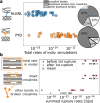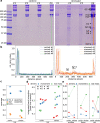Collagen breaks at weak sacrificial bonds taming its mechanoradicals
- PMID: 37045839
- PMCID: PMC10097693
- DOI: 10.1038/s41467-023-37726-z
Collagen breaks at weak sacrificial bonds taming its mechanoradicals
Abstract
Collagen is a force-bearing, hierarchical structural protein important to all connective tissue. In tendon collagen, high load even below macroscopic failure level creates mechanoradicals by homolytic bond scission, similar to polymers. The location and type of initial rupture sites critically decide on both the mechanical and chemical impact of these micro-ruptures on the tissue, but are yet to be explored. We here use scale-bridging simulations supported by gel electrophoresis and mass spectrometry to determine breakage points in collagen. We find collagen crosslinks, as opposed to the backbone, to harbor the weakest bonds, with one particular bond in trivalent crosslinks as the most dominant rupture site. We identify this bond as sacrificial, rupturing prior to other bonds while maintaining the material's integrity. Also, collagen's weak bonds funnel ruptures such that the potentially harmful mechanoradicals are readily stabilized. Our results suggest this unique failure mode of collagen to be tailored towards combatting an early onset of macroscopic failure and material ageing.
© 2023. The Author(s).
Conflict of interest statement
The authors declare no competing interests.
Figures





Similar articles
-
Hidden length lets collagen buffer mechanical and chemical stress.Phys Rev E. 2024 Nov;110(5-1):054408. doi: 10.1103/PhysRevE.110.054408. Phys Rev E. 2024. PMID: 39690676
-
Mechanoradicals in tensed tendon collagen as a source of oxidative stress.Nat Commun. 2020 May 8;11(1):2315. doi: 10.1038/s41467-020-15567-4. Nat Commun. 2020. PMID: 32385229 Free PMC article.
-
Mechanical stretching changes crosslinking and glycation levels in the collagen of mouse tail tendon.J Biol Chem. 2020 Jul 31;295(31):10572-10580. doi: 10.1074/jbc.RA119.012067. Epub 2020 Jun 16. J Biol Chem. 2020. PMID: 32546479 Free PMC article.
-
Structure of the tendon connective tissue.Scand J Med Sci Sports. 2000 Dec;10(6):312-20. doi: 10.1034/j.1600-0838.2000.010006312.x. Scand J Med Sci Sports. 2000. PMID: 11085557 Review.
-
Mechanics and structural stability of the collagen triple helix.Curr Opin Chem Biol. 2019 Dec;53:98-105. doi: 10.1016/j.cbpa.2019.08.001. Epub 2019 Oct 11. Curr Opin Chem Biol. 2019. PMID: 31606538 Review.
Cited by
-
Mineral and cross-linking in collagen fibrils: The mechanical behavior of bone tissue at the nano-scale.J Mech Behav Biomed Mater. 2024 Nov;159:106697. doi: 10.1016/j.jmbbm.2024.106697. Epub 2024 Aug 22. J Mech Behav Biomed Mater. 2024. PMID: 39182252 Free PMC article.
-
Historical evolution, hotspots, and trends in tendon tissue engineering: A bibliometric analysis.Regen Ther. 2025 May 6;29:600-612. doi: 10.1016/j.reth.2025.04.009. eCollection 2025 Jun. Regen Ther. 2025. PMID: 40487919 Free PMC article.
-
Multiscale and multidisciplinary analysis of aging processes in bone.NPJ Aging. 2024 Jun 15;10(1):28. doi: 10.1038/s41514-024-00156-2. NPJ Aging. 2024. PMID: 38879533 Free PMC article. Review.
-
Shock-Induced Degradation of Guanosine and Uridine Promoted by Nickel and Carbonate: Potential Applications.Molecules. 2023 Dec 8;28(24):8006. doi: 10.3390/molecules28248006. Molecules. 2023. PMID: 38138495 Free PMC article.
-
What Is the Sequence of Mechanical and Structural Failure During Stretch Injury in the Rat Median Nerve? The Neuroclasis Classification.Clin Orthop Relat Res. 2025 Jun 1;483(6):1142-1158. doi: 10.1097/CORR.0000000000003405. Epub 2025 Feb 18. Clin Orthop Relat Res. 2025. PMID: 40192591
References
-
- Staudinger E, Leupold H. Über Isopren und Kautschuk, 18. Mitteil.: Viscosittäts-Untersuchungen an Balata. Ber Dtsch Chem Ges. 1930;63:730–733. doi: 10.1002/cber.19300630329. - DOI
-
- Luo, Y.-R. Comprehensive Handbook of Chemical Bond Energies (CRC Press, 2007).
Publication types
MeSH terms
Substances
Grants and funding
LinkOut - more resources
Full Text Sources

